Under the 800V high-voltage platform, the vehicle battery system, charging system, and electric drive system must all be developed towards the high-voltage platform. As the core of the three-electric system, the efficiency of the motor directly affects the performance of the vehicle. Under the 800V architecture, the design of the motor is also different from that of the low-voltage platform, requiring the electric drive system to move towards high efficiency, lightness, and low cost. In this context, motors wound with flat copper wires are increasingly favored by suppliers and OEMs.
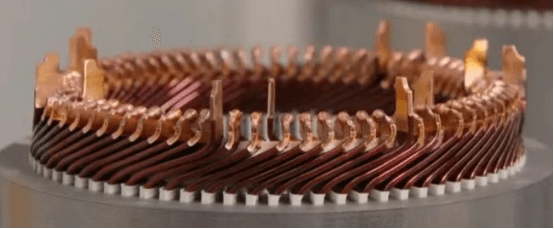
Hairpin Motor Winding Form
According to the manufacturing process, there are three main types of winding methods for flat wire motors: Hair-pin, I-pin and continuous wave winding.
1. I-pin Winding

I-pin winding is an axial embedded winding. The flat wire conductor is directly embedded axially in the core slot, and then the two ends are twisted and welded. The manufacturing process is relatively simple, but the welding part occupies additional radial dimensions, the tail is long, the copper loss is large, and the efficiency will decrease as the temperature increases.
2. Hair-pin Winding
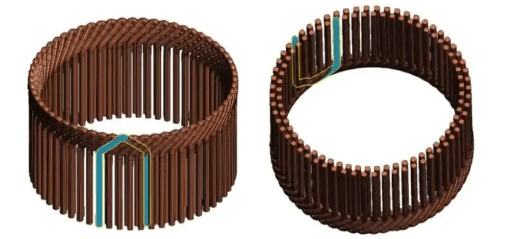
The manufacturing process of Hair-pin winding is relatively complicated compared with I-pin winding, and there is an additional preforming step in the manufacturing process. Hair-pin winding requires flat copper wire to be preformed into a hairpin shape, and the other end is a welding end, which makes the manufacturing process more difficult. However, due to the reduction of welding at one end, the overall copper consumption is lower than that of I-pin winding, and the motor efficiency is also improved to a certain extent.
In addition to the difficulty of the forming process, the process difficulty of flat wire hairpin winding also lies in the insulation treatment of the winding end to avoid direct contact between the winding and the stator. At the same time, in order to ensure a compact structure, the gap between the windings must be small enough. Small gaps will bring two problems: small gaps have small process tolerances, and areas with small breath are prone to turn-to-turn breakdown short circuits and hidden inherent defects.
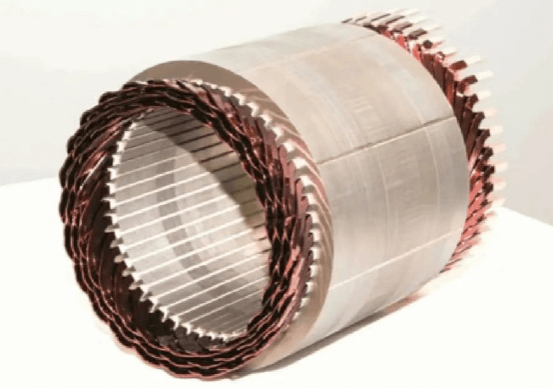
The damage problem of inter-turn resin insulation material is generally solved by installing insulating paper inside the gap between windings, but the process cost is high.
The winding of the hairpin motor also encounters a limit in the end height. The end of the conventional hairpin winding is presented in the form of a triangle, and the end height Lc is limited by the angle θ of the triangle and the gap.
"Triangle" end structure, height restriction
To address the problem of winding height, DENSO has adopted a stepped end design to reduce the turning radius of the winding, so that the end height Lc is less constrained by the angle θ of the triangle side, and the winding structure is more compact. In order to solve the problem of insulation between windings, DENSO adds high molecular polymer insulation materials on the basis of flat wire basic insulation, so that different coils can meet the insulation requirements even after contact.
On the basis of the basic insulation of the flat wire, additional high molecular polymer insulation material is added.
It is worth noting that although the hairpin and I-pin windings are comparable in terms of maximum efficiency and peak torque, and the I-pin winding process is simpler. However, due to the solder joint problem, the increased solder joints also increase the risk of failure, so the hair-pin winding process is widely used at home and abroad. At present, Tesla's 22 Model 3/Y rear-wheel drive has been equipped with a hair-pin winding flat wire motor.
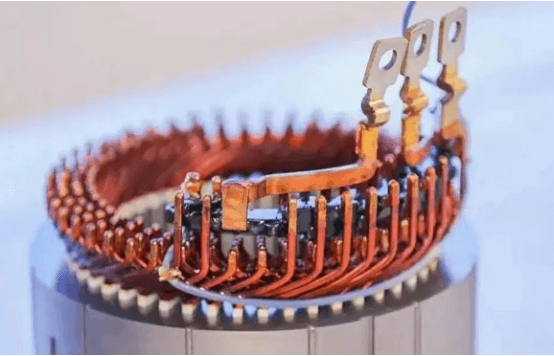
3. Continuous Wave Winding
Wave-wound flat wire is a winding process with few solder joints and high design flexibility, but the current coil arrangement has the following main problems:
The asymmetric winding branches lead to differences in back electromotive force, resistance, and inductance, which reduces motor performance. At the same time, the winding circulating current will increase the additional loss of the motor and cause local overheating of the motor.
The motor winding is difficult to arrange, easy to overlap, and difficult to put into the stator slot.
When the span of the wave winding is different, the production process is complicated, the mold investment cost is high, and the production difficulty is great.
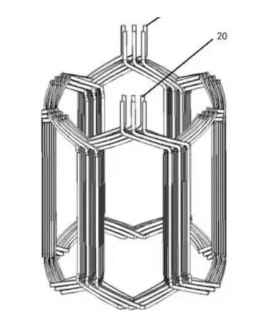
Motor Cooling and Heat Dissipation Research
The application of 800V high-voltage platform and flat wire winding technology will inevitably lead to the development of motors in the direction of high power and high speed. Especially in motors with Hairpin windings, due to the heat loss caused by skin effect and eddy current, not only the overall efficiency of the motor is reduced, but also the motor is prone to magnet demagnetization, insulation material aging and reduced service life of drive units such as gearboxes when running in high temperature environment for a long time. Therefore, this puts forward new requirements for the heat dissipation means of the motor.
There are three main means of motor cooling, namely air cooling, oil cooling and water cooling. Due to the limited heat dissipation effect of air cooling, the existing motors rarely use this cooling form.
The water-cooled motor borrows the cooling method of the engine in the oil car and uses a mixture of cooling water and ethylene glycol to cool the motor through the cooling circuit of the shell. However, as the power density of the motor increases, it is often necessary to directly cool the heat source to obtain a good heat dissipation effect. The conductive and magnetic properties of water itself, as well as the low boiling point and easy expansion make it difficult for the existing water cooling technology to meet the high power requirements of the motor.
Oil cooling is the main cooling method currently used. The cooling oil itself is non-conductive and non-magnetic, and can directly cool the gear shaft, stator, etc. inside the motor housing, which can achieve a good cooling effect. In addition, by adjusting the formula of the cooling oil, it can also lubricate the parts inside the electric drive system while cooling. Therefore, the use of an oil cooling solution with a good ratio will become the mainstream trend of future motor cooling solutions.
Based on the above oil cooling measurement, many new forces have also considered intelligent oil temperature measurement in the all-in-one motor technology. Taking Huawei's One-drive high-speed intelligent oil-cooled four-wheel drive system as an example, it plans to use a spray oil channel design to directly cool friction-heat-generating parts such as gear shafts to achieve the best cooling effect.
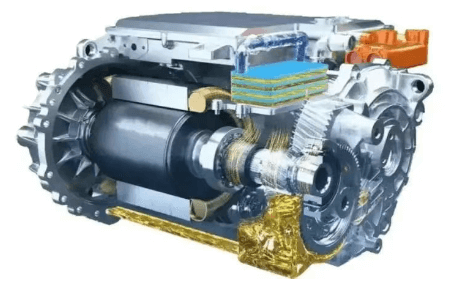
Hairpin Winding Transposition Technology for Automobile Drive Motor
1. Foresight
The drive motor is the core power source of new energy vehicles. With the gradual increase in the requirements for lightweight, low cost, and high reliability of new energy vehicles, increasingly stringent requirements are put forward for the power density, peak efficiency, and high efficiency zone of the drive motor.
The current solution is mainly focused on the design and control method of the magnetic circuit structure of the drive motor, which has limited contribution to the improvement of power density and efficiency. The winding loss accounts for about half of the total loss of the drive motor, especially when the high speed and high frequency account for a larger proportion of the loss. Therefore, breaking through the winding design technology of the automotive drive motor is not only an effective solution to improve the power density and efficiency of the drive motor, but also a forward-looking technology to improve the insulation level and voltage level of the motor winding in the future.
At present, flat wire hairpin windings are widely used in automotive drive motors. The winding is characterized by the close insertion of multiple single-turn copper flat wires in the slot along the height direction, and the ends of the copper flat wires are twisted and welded using a special process. Since the number of layers of the flat wire hairpin winding is limited, the cross-sectional area of the copper flat wire is large, resulting in a large additional loss of eddy current in the copper flat wire. In addition, the automobile drive motor often works in high-frequency and high-harmonic conditions, which will cause reduced efficiency and serious heat generation. In addition, the slot insertion, end twisting and welding processes used in the flat wire hairpin winding are extremely complex, the cost of the entire production line is high, and serial production is difficult. In order to overcome the limitations of the flat wire hairpin winding, a transposition technology for the flat wire winding of the automobile drive motor is proposed. This technology uses multiple small-section copper flat wires to form a transposition structure, which can effectively reduce additional losses and improve efficiency and power density; the ends of the flat wire transposition winding do not require welding, the process is simple, the cost is low, and it is easy to serialize production; the flat wire transposition winding can realize the integrated design of the strands, effectively improving the insulation level and heat dissipation capacity of the winding; the flat wire transposition winding can be standardized, and the detection and evaluation before the end of the winding can be realized, which effectively improves the operation reliability of the winding.
2. Leadership
The hairpin winding transposition technology for automotive drive motors has broken through the basic and cutting-edge bottlenecks in design, manufacturing, testing, and evaluation. Its technological leadership is mainly reflected in the following three aspects: a theoretical system for the flat wire winding transposition technology for automotive drive motors has been proposed. Aiming at the bottleneck problems of winding transposition such as short axial length, short end, large number of poles, and small number of slots for automotive drive motors, a continuous transposition idea based on leakage potential compensation has been proposed, which has achieved balanced stator winding electrical load, low additional loss, high efficiency, and uniform temperature rise distribution in the entire domain; for complex transposition structures, a three-dimensional electromagnetic heat numerical simulation method has been proposed, which has achieved accurate prediction of temperature rise monitoring points.
Hairpin winding transposition technology
The general transposition design method and design technology for the series of flat wire transposition winding products of automotive drive motors are proposed. A general transposition design method based on discrete integral method, equivalent circuit network method, and multi-variable multi-objective optimization algorithm is proposed, and a general transposition design software is developed. The bottleneck problem of transposition design method and design technology is solved, and a new transposition design technology is provided for the series of flat wire transposition winding products of automotive drive motors and the research and development of new products.
General transposition design software for hairpin transposition winding
A multi-channel parallel winding strand current detection system and flat wire transposition winding evaluation technology are developed. Traditional research has not solved the problem of experimental testing of circulating current under the tightly connected parallel structure of multi-channel parallel winding strands of flat wire transposition windings. This technology proposes a real-time test method for the circulating current of multi-channel parallel winding strands of flat wire transposition windings, builds a measurement platform, and develops a linear array strand current sensor, and then develops an online evaluation technology and fault diagnosis technology for flat wire winding transposition, overcoming the problem of circulating current detection and transposition evaluation.
3. Disruptive
Automotive drive motor winding technology has gone through the development process of the first generation of conventional round scattered wire winding and the second generation of flat wire hairpin winding, and has initially achieved high slot fill rate, high power density and lightweight. Flat wire winding transposition technology can not only change the complex manufacturing process of automotive drive motors and reduce costs, but also break through the upper limit of automotive drive motor power density, peak efficiency and high efficiency zone, and is expected to replace flat wire hairpin winding as the third generation winding of automotive drive motors. This technology subverts the scattered wire mode of the first two generations of winding strands, and fully realizes the multi-objective collaborative design of winding loss, insulation, heat dissipation, etc.
Flat wire transposition winding achieves efficiency improvement through disruptive means, making full use of the parallel winding and transposition pitch selection of strands to balance the leakage magnetic chain of each flat copper wire, which can minimize the additional loss. Compared with round scattered wire winding and flat wire hairpin winding, it can improve the efficiency of automotive drive motors, especially for high-speed and high-frequency conditions, the additional loss reduction effect is significant, and the high efficiency zone of automotive drive motors can be widened.
Flat wire transposed winding has overturned the design method and design concept of round loose wire winding and flat wire hairpin winding. The design scheme of flat wire transposed winding is flexible and diverse. There is no restriction on the number of layers of flat wire hairpin winding. Different winding arrangement schemes and transposition methods can be designed according to technical requirements.
Hairpin transposition winding has overturned the manufacturing process of round scattered wire winding and flat wire hairpin winding. It not only takes into account the advantages of round scattered wire winding winding and unwinding process, but also saves the process of slot wire insertion, end twisting, welding and other processes of flat wire hairpin winding, reduces production costs, and can also realize the integrated design of strands, leaving room for improving the insulation level and voltage level of windings.
The transposition technology of hairpin windings for automotive drive motors solves the basic and cutting-edge bottleneck problems in multiple dimensions such as design, testing, and evaluation, and forms a transposition technology system for flat wire windings for automotive drive motors. This technology can save the complicated process of slot wire insertion, end twisting, welding, etc. of flat wire hairpin winding, and there is no need to purchase the expensive flat wire hairpin winding production line, which greatly reduces the production and manufacturing cost of automobile drive motors; moreover, compared with the second-generation flat wire hairpin winding, it can reduce the additional loss of automobile drive motors under all working conditions, reduce the temperature rise of the motor, improve the operating reliability, and is expected to break through the upper limit of the power density, peak efficiency and high efficiency zone of automobile drive motors; this technology is also convenient for improving the insulation level of motor windings, laying a technical foundation for the future improvement of the voltage level of automobile drive motors.
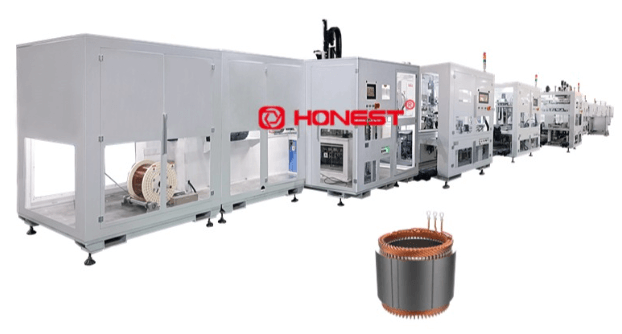
HONEST Automation is dedicated to continuous innovation in Hairpin Motor Winding technology. Our third-generation Hairpin motor assembly line features a more compact design, improved user-friendly operation, and significantly enhanced accuracy and stability. We have successfully delivered high-efficiency, fully customized production lines to leading automotive OEMs and electric drive system manufacturers worldwide.
Contact our engineering team today for a free one-on-one consultation and discover how HONEST can help you build a smart manufacturing solution tailored for the next generation of electric drive systems.











